#akohekohe
Photo

‘Ākohekohe aka Crested Honeycreeper (Palmeria dolei)
Photographed by Jim Denny.
#photography#animals#birds#‘Ākohekohe#Akohekohe#Crested Honeycreeper#Honeycreeper#Palmeria dolei#Jim denny
83 notes
·
View notes
Text
Animal of the Day!
‘Akohekohe (Palmeria dolei)

(Photo by Rich Downs)
Conservation Status- Critically Endangered
Habitat- Maui
Size (Weight/Length)- 18 cm
Diet- Nectar
Cool Facts- The ‘akohekohe is the largest honeycreeper species found on the Hawaiian island of Maui. They specialize on the uniquely shaped flowers throughout the tropical highlands. The distinct crest of feathers at the top of their beak aids in pollination when they stick their heads deep inside flowers to lick at the nectar. ‘Akohekohe are relatively aggressive and chase away other honeycreeper species in their territory. Unfortunately, alongside many other honeycreepers, the ‘akohekohe is at threat from avian malaria from mosquitoes and invasive species like rats. They were added to the Endangered Species Act in 1967 and eradication attempts of invasive species are helping to increase the ‘akohekohe population.
Rating- 13/10 (Vaccination experimentation hopes to solve the avian malaria issue.)
#animal of the day#animals#birds#honeycreeper#monday#november 6#'Akohekohe#biology#science#conservation#the more you know
136 notes
·
View notes
Text

[112/10,976] 'Akohekohe - Palmeria dolei
Order: Passeriformes
Suborder: Passeri
Superfamily: Passeroidea
Family: Fringillidae (true finches)
Subfamily: Carduelinae (cardueline finches)
Photo credit: Luke Seitz via Macaulay Library
#birds#'Akohekohe#Passeriformes#Passeri#Passeroidea#Fringillidae#Carduelinae#Palmeria#birds a to z#undescribed#0% - 25%
4 notes
·
View notes
Photo

🔥 Critically Endangered Akohekohe. Endemic to Maui (Hawaii)
1 note
·
View note
Photo

#akohekohe para @onemilliononemonth #onemilliononemonth #1m1mvol2 #awareness #endangeredspecies #drawing #blackwing #pencil #pencildrawing #illustration #ilustracion https://www.instagram.com/p/CAZBW2cjl8G/?igshid=1v3nq6gggacxo
#akohekohe#onemilliononemonth#1m1mvol2#awareness#endangeredspecies#drawing#blackwing#pencil#pencildrawing#illustration#ilustracion
0 notes
Text
Palmeria dolei

By Douglas Pratt
Etymology: For Henry C. Palmer
First Described By: Wilson, 1891
Classification: Dinosauromorpha, Dinosauriformes, Dracohors, Dinosauria, Saurischia, Eusaurischia, Theropoda, Neotheropoda, Averostra, Tetanurae, Orionides, Avetheropoda, Coelurosauria, Tyrannoraptora, Maniraptoromorpha, Maniraptoriformes, Maniraptora, Pennaraptora, Paraves, Eumaniraptora, Averaptora, Avialae, Euavialae, Avebrevicauda, Pygostaylia, Ornithothoraces, Euornithes, Ornithuromorpha, Ornithurae, Neornithes, Neognathae, Neoaves, Inopinaves, Telluraves, Australaves, Eufalconimorphae, Psittacopasserae, Passeriformes, Eupasseres, Passeri, Euoscines, Passerides, Core Passerides, Passerida, Passerid Clade, Fringillidae, Carduelinae, Drepanidini
Status: Extant, Critically Endangered
Time and Place: Within the last 10,000 years, in the Holocene of the Quaternary


The ‘Akohekohe is known only on the island of Maui in Hawai’i

Physical Description: ‘Akohekohe are a species of Hawai’ian Honeycreepers, a type of extremely unique passerine threatened with extinction due to mammalian invaders on the island. ‘Akohekohe are medium-sized perching birds, extremely distinctive in appearance - 18 centimeters long, with males somewhat heavier than females; both sexes have the same set of extremely distinctive patterns. The birds have white fluffy tufts of feathers above their long, thin, curved beak; black patches underneath the fluff on the head, with an orange patch around the eye. The neck and cheeks have black and white spottled feathers in distinctive patterns, while the back of the neck is red in color. The back itself is red and black, while the belly is red, white, and black. The wings have black and red spots on the shoulder, with black and white feathers on the wing. Finally, the butt is white, the back of the rump is red, and the tail feathers are short and black with white tips. One of the most distinctive and brilliantly patterned birds out there! The females have similar patterns, but are duller in color.
Diet: These are nectar specialists, feeding on the nectar of Ohia flowers, raspberry flowers, pukiawe, ohelo, kolea, and kanawao. Sometimes it will eat caterpillars, flies, and spiders.

By John Gerrard Keulemans, in the Public Domain
Behavior: The ‘Akohekohe will feed in lines on blooming trees, usually going from tree to tree in a regular cycle - even defending territories of trees they claim as their own to prevent other members of the species from feeding there. They make weirdly human-like whistles to one another, before making eerie echoing whistles in response. As for songs, they make reedy whistles and even cowbell-like grunts and squawks to one another. They even make weird ahh-ko-he-ko-heh calls, hence its name!
This bird breeds in small colonies, with each colony adjacent to one another. The males make huge, aerial acrobatic displays to attract females, before singing high in the forest canopy; the mated pairs will feed each other throughout the breeding cycle from November through June. Females build the nests out of twigs, tossed with moss and lichens, usually about 14 meters above the ground in the upper layers of the canopy. They lay one or two grey eggs that are incubated by the female and guarded by the male for two weeks; both parents then feed the babies for three more weeks. These birds mainly migrate in search of open Ohia flowers.
Ecosystem: The ‘Akohekohe live in ohia-lehue dominated forests with koa trees and dense olapa in the understorey; which means they’re almost all above 1500 meters in elevation.

By the U.S. Pacific Island Ecosystems Research Center, in the Public Domain
Other: The ‘Akohekohe used to be much more common and have a much larger range than today; populations initially took a hit after the settlement of Polynesians, as they cut down forests to make farmland, destroying the habitat of the birds. However, they did bounce back some from that, and it was sustainable. The arrival of Europeans lead to even more deforestation and the arrival of rats and cats. These animals attacked the eggs, chicks, and adults of many birds, and also ate the flowers (in the case of the rats) that the birds rely on. The unusual appearance of the ‘Akohekohe also lead to collectors poaching it, leading to even more decline. Mosquitoes introduced to Hawai’i spread dangerous diseases to the birds. Invasive birds released by European settlers on the island also lead to sharp declines in population.
Today, there are not many of these birds left; climate change also severely threatens them. It’s protected by law today, well, by like ten different laws; recovery plans are in place to try and keep the birds safe, and many of their habitats are very well closed off. Hopefully, continued responsible practices will keep this bird around, but it’s a delicate situation.
~ By Meig Dickson
Sources under the Cut
Jobling, J. A. 2010. The Helm Dictionary of Scientific Bird Names. Christopher Helm Publishing, A&C Black Publishers Ltd, London.
Pratt, D. (2019). Akohekohe (Palmeria dolei). In: del Hoyo, J., Elliott, A., Sargatal, J., Christie, D.A. & de Juana, E. (eds.). Handbook of the Birds of the World Alive. Lynx Edicions, Barcelona.
#Palmeria#Palmeria dolei#Hawai'ian Honeycreeper#'Akohekohe#Dinosaur#Bird#Songbird#Passeriform#Birblr#Factfile#Birds#Dinosaurs#Quaternary#Australia and Oceania#Necgtarivore#songbird saturday & sunday
80 notes
·
View notes
Photo





Some more of my quick bird paintings, this time Russian/central asian and North american birds.
P1: Baikal teal, crested shelduck, siberian white crane, pied harrier, brown hawk owl, black francolin
P2: Ibisbill, Ross’ gull, snow pigeon, spoon-billed sandpiper, crested auklet, wire-tailed swallow
P3: White-throated rock thrush, Severtzov’s tit-warbler, red-cheeked starling, himalayan rubythroat, daurian starling, Henderson’s ground jay
P4: Wood duck, tufted puffin, lesser prarie chicken, anahinga, spoonbill, northern saw-whet owl
P5: Red-breasted sapsucker, scissor-tailed flycatcher, nortern parula, Anna’s hummingbird, blue jay, akohekohe
#watercolour#birds#bird#birdblr#teal#duck#crane#harrier#owl#francolin#hen#gull#pigeon#sandpiper#auk#swallow#thrush#warbler#starling#jay#puffin#chicken#anahinga#spoonbill#woodpecker#flycatcher#hummingbird
433 notes
·
View notes
Text
Maui Forest Birds Critically Threatened
Maui Forest Birds Critically Threatened
The kiwikiu, or Maui parrotbill, is only found in East Maui. There are less than 312 remaining in the wild
A new interagency monitoring report on Hawaiian forest birds indicates that remaining populations of at least two native endemic species of Maui forest birds are in rapid decline.
The surveys conducted in the report were the largest and most comprehensive interagency effort to research East…
View On WordPress
#akohekohe#crested honeycreeper#Haleakala National Park#Hanna L. Mounce#Hawaii Department of Forestry and Wildlife#Hawaii Department of Land Natural Resources Plant Extinction Prevention Program#Kahikinui Forest Reserve#KIWIKIU#Maui Forest Bird Recovery Project#Maui forest birds#Maui parrotbill#Nakula Forest Reserve#Natalie Gates#National Park Service Inventory and Monitoring Pacific Island Network#Pacific Cooperative Studies Unit#Seth Judge#State of Hawaii Division of Forestry and Wildlife#United States Geological Survey#University of Hawaiʻi at Hilo#USGS#weeklynews
0 notes
Photo

Akohekohe in Ohia, Lithograph by Marian Berger
1 note
·
View note
Photo

‘Akohekohe Study. 5”x7” Watercolor. Check out my website daily for deals on studies and small paintings. #watercolor #painting #studysales (at Puna, Hawaii)
1 note
·
View note
Photo

‘Ākohekohe aka Crested Honeycreeper (Palmeria dolei)
58 notes
·
View notes
Text
submission from @telepathic–heart
Hey, check out these cool endemic birds from Haleakala Forest Reserve, Maui, Hawaii!
Kiwikiu

Kiwikiu live up to 16 years, and produce offspring every one or two years on average. They form monogamous pairs and defend a territory up to 20 acres. There are only about 500 known birds left in the world.
‘Apapane

‘Apapane are most well known for their songs, which can be pretty and methodical or harsh and mechanical-sounding. In most cases, the male who is the most aggressive and sings the loudest is the one who gets the female’s attention. About 1,080,000 of these birds exist in Hawaii’s protected mountain forests.
I'iwi

I'iwi have deeply curved bills to collect nectar from flowers, and have a haunting call which has been described as “A child playing a rusty harmonica in the woods.” They’ve experienced the greatest decline in population of any Hawaiian honeycreeper. There are about 350,000 of these birds left.
‘Akohekohe

'Akohekohe are often characterized by their white crest on their foreheads, and their volcanic pallet. They live only in a 50 square kilometer space on Haleakala volcano, and they have a population of about 3700.
Po'ouli

Po'ouli are the rarest birds in the world, and as of 2004 there were only two in existence. Their behaviors are largely undocumented due to their rarity. These birds haven’t been seen since the study in 2004, and are possibly extinct.
#avianpostgenerator#submission#this is incredibly well researched n cool to read#id feel bad if i did not give more credit#birds
72 notes
·
View notes
Text
What’s Killing Hawaii’s Forest Birds?
In the last 200 years, 17 out of 41 species of Hawaiian honeycreeper have gone extinct. Another 14 are endangered.
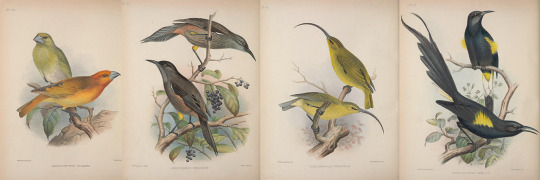
Extinct Hawaiian Honeycreepers (Left to Right): Greater Koa Finch (Rhodacanthis palmeri), Kauai 'O'o (Moho braccatus), Hawaii 'Akialoa (Hemignathus obscurus), Hawaii 'O'o (Moho nobilis)
From: Birds of the Sandwich Islands, By Wildon Scott (1899)
Courtesy of the Smithsonian Institute
In the early 1900’s, a silent killer began stalking the natural and cultural heritage of Hawaii. From the mountains to the shoreline (mauka to makai) the forests of Hawaii were falling silent. Something was killing Hawaii’s honeycreepers - a unique family of birds not found anywhere else on the planet.
The ancestors of the honeycreepers arrived on the newly formed Hawaiian islands millions of years ago and quickly evolved to fill the empty landscape with dozens of new and unique species, a process called adaptive radiation.
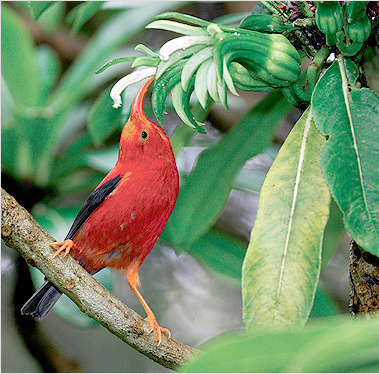
An feeds i’iwi on a lobeliad flower. Photo Credit: Jack Jeffrey
Naturalists began to record the disappearances of many endemic Hawaiian species in the late 1800’s. Habitat loss and introduced predators like cats, rats, and pigs were taking their toll on all of the native plant and animal populations.
But as the decades passed and the species continued to disappear, it seemed as if something other than habitat loss and predation was impacting Hawaii’s birds - particularly the honeycreepers. The huge flocks of ‘I’iwi that once roamed the mountainsides foraging for food had disappeared, even from seemingly pristine lowland forest.

Endangered Hawaiian Honeycreepers (Left to Right) Akiapolaau © Jack Jeffrey Photography, Akohekohe © Jack Jeffrey Photography, Amakihi © Jack Jeffrey Photography, Hawaii Akepa © Jack Jeffrey Photography
By the 1960’s biologist Richard Warner believed he had identified the culprit. The answer lay in the pattern of disappearance. The birds were disappearing from healthy lower elevation forests but were still present in the higher elevation forests where the temperatures were cooler. Whatever was killing the birds, it was only happening at lower elevations. The culprit, he theorized, was a disease found commonly in bird species across the planet - mosquito borne avian malaria.
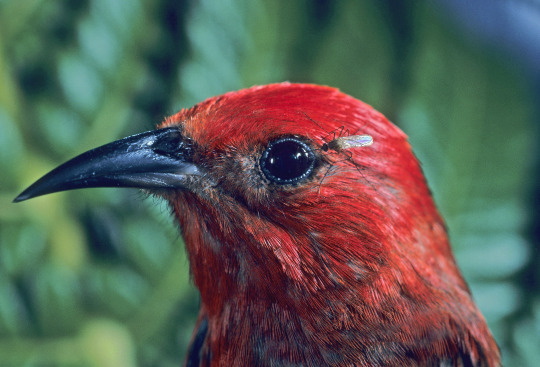
Apapane with a mosquito. Photo © Jack Jeffrey Photography
Avian malaria itself probably came to Hawaii in the early 1900’s when domesticated birds were imported into the lowland cities. These introduced birds almost certainly carried avian malaria, but the disease never would have spread to the native bird population if it hadn’t been for another earlier invader - the mosquito Culex quinquefasciatus. The Culex quinquefasciatus species is the only known vector of avian malaria. Without Culex, the disease cannot spread.
In the vast majority of bird species, the parasites (members of the genus Plasmodium) have little to no impact on the health of the infected birds. Long exposure to the parasite has allowed most species around the world to evolve effective disease resistance.
For many of Hawaiiʻs forest birds, which evolved in the isolation of the world’s most remote archipelago without exposure to malaria or mosquitoes, the impacts have been catastrophic. Wherever the forest birds range overlapped with mosquito populations, the birds have disappeared.
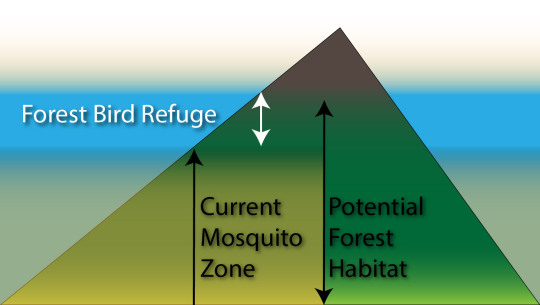
Mosquitos breed and thrive at lower and warmer elevations where they infect birds with avian malaria and pox. Higher and cooler elevation forests, where mosquitoes and their diseases do not thrive, have become the only refuges for Hawaii’s forest birds, but even those areas are now under threat. As temperatures rise, mosquitoes, and the avian diseases they carry, have begun to spread upwards into the mountains further constricting habitat.
“For decades, we had reached this equilibrium. The birds had moved into the upper elevation forests where they had this area of refuge from mosquitoes and avian malaria, but now that's being threatened,” said Josh Fisher, Invasive Species Biologist with the Pacific Islands Fish and Wildlife Office .
Today, nearly every species of Hawaiian honeycreeper is facing shrinking ranges and declining populations. In the last 200 years, 17 out of 41 known species of honeycreeper have gone extinct. Another 14 are endangered. On the island of Kauai, every species of native forest bird is in decline. Ninety percent of the ‘i’iwi’ population is confined to a narrow band of forest on the windward slopes of the island of Hawaii, between 4,000 and 6,000 feet (1,300 and 1,900 meters) in elevation. “We are at this point where some of these populations are so low or so dependent on a single area, that a single catastrophic event could spell the end of a species” said Josh Fisher, Invasive Species Biologist with the Pacific Islands Fish and Wildlife Office .
“There’s an urgency now that didn’t exist before because warming temperatures are already starting to push mosquitoes into the upper elevations of places like Kauai. There really isn't anywhere else for these birds to go. They can't go down and they can't really go up much higher.”
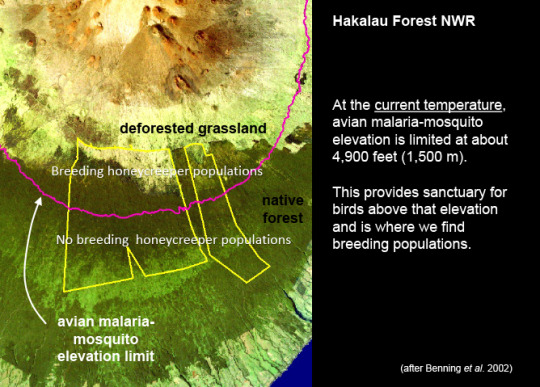
For decades researches have watched as avian malaria reduced bird ranges and pushed population declines across all of the low elevation forests of Hawaii. “We’ve known what the problem is, but with avian malaria there isn't a tool that we can just pull out of a box to fight this. We have to develop the tool,” said Fisher.
Places like Hakalau Forest National Wildlife Refuge are tackling habitat loss by aggressively planting native species and restoring forests. James Campbell National Wildlife Refuge and Kilauea Point National Wildlife Refuge are using predator proof fences to keep out invasive predators and protect birds. But introduced diseases are more difficult to address. “Fortunately over last decade there have been significant advances in how to address mosquitoes at the landscape scale,” said Fisher.
Biologists and conservationists across Hawaii are working to find ways to save the honeycreepers: from dealing with predation by introduced species to landscape scale control of mosquitoes. Now more than ever, it is important to work with our partners to protect these species for future generations.
This story is part of a series examining the issues impacting Hawaii’s forest birds. Read the other stories in the series here.
Hawaii’s Magnificent Forest Birds
ʻŌhiʻa lehua: the Foundation of Hawaii’s Forest Ecosystem
Want to dive deeper?
Collapsing avian community on a Hawaiian island
Paxton, Eben; Camp, Richard J.; Gorresen, P. Marcos; Crampton, Lisa H.; Leonard, David L.; VanderWerf, Eric
Abundance, distribution, and population trends of the iconic Hawaiian Honeycreeper, the ʻIʻiwi (Vestiaria coccinea) throughout the Hawaiian Islands
Paxton, Eben H.; Gorresen, P. Marcos; Camp, Richard J.
Large-Scale Range Collapse of Hawaiian Forest Birds under Climate Change and the Need 21st Century Conservation Options.
Fortini LB, Vorsino AE, Amidon FA, Paxton EH, Jacobi JD
For more stories of conservation in the Pacific, follow https://www.facebook.com/pg/PacificIslandsFWS
#hawaii#Hakalau Forest#Hakalau national wildlife refuge#iiwi#Forest#forestbird#honeycreeper#hawaiian honeycreeper#maui#kauai#oahu#evolution#science#conservation#endangered#endangered species#USGS#avian malaria#birds#Birdwatching#birding
122 notes
·
View notes
Photo

Akohekohe, critically endangered with only 3,800 individuals left and decreasing. It is endemic to the island of Maui in Hawaii. Main threats are climate change and agriculture. . . . #climatechange #agriculture #akohekohe#plasticocean #enviroment #nature #savetheplanet#ocean #plastic #plasticocean #savetheearth#educateyourself #educate#animals #endangeredanimals https://www.instagram.com/p/ByU3UUVCqfd/
0 notes
Text
Akohekohe Englisch übersetzung - Englisch Bedeutung für Akohekohe
Was ist die englische Bedeutung von Akohekohe.
Akohekohe auf Englisch übersetzen
Akohekohe Englisch übersetzung #Akohekohe
0 notes